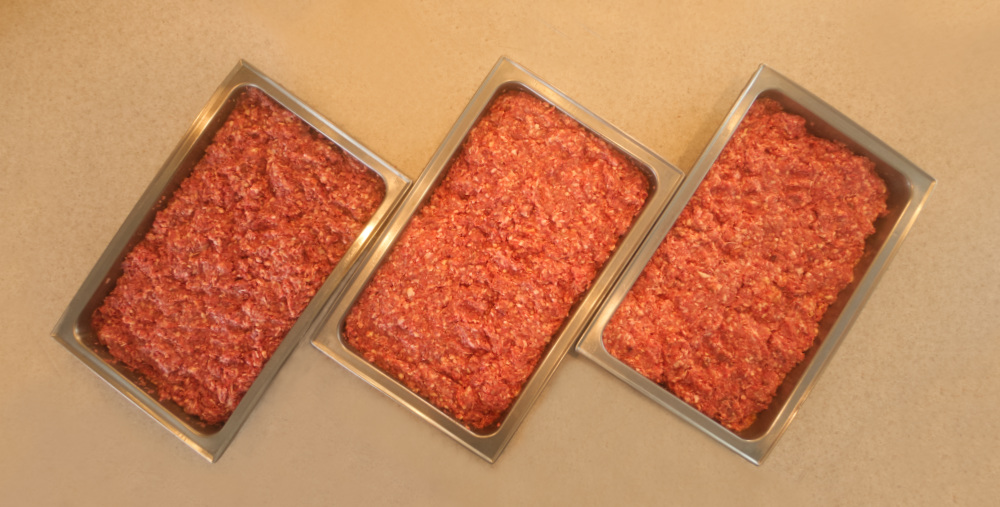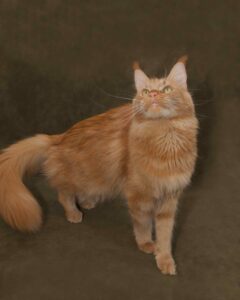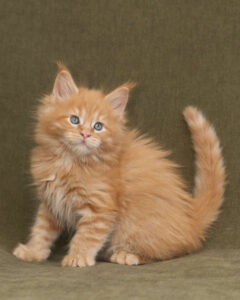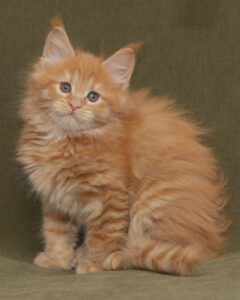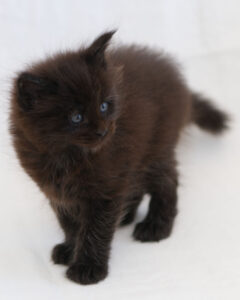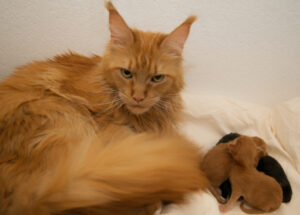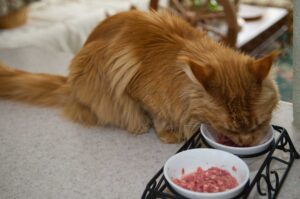Table of Contents
Let’s Cover the Basics First
What is “Natural” Cat Food Exactly?
In the context of homemade raw cat food recipe, “natural” refers to creating a diet that mirrors what a cat would consume in the wild — primarily whole prey. This means using whole cuts of meat, including muscle meat, organs, skin, and bones, to provide nutrients in th0-ity supplements can play a crucial role in ensuring nutritional completeness, the goal of a natural recipe is to source as many nutrients as possible directly from whole food ingredients.
The Raw Feeding Decision
A key reason many pet parents choose a raw, natural diet is to preserve heat-sensitive nutrients. Taurine, an essential amino acid for cats, is particularly vulnerable to degradation through high-heat cooking. Other vitamins and amino acids can also be diminished. While it is possible to create a nutritionally complete cooked diet, it requires careful supplementation with synthetic taurine and other nutrients added after cooking to ensure potency. A well-prepared raw diet aims to provide these nutrients directly from the food itself.1
Are you ready to make your own homemade raw cat food? Let’s get started!
Essential Whole-Prey Homemade Recipe
This recipe is designed to mimic the nutritional profile of a cat’s natural prey. Always consult with a veterinarian or a certified veterinary nutritionist before switching your cat to a homemade diet.
Yields: Approximately 12 lbs of food
Daily Feed Amount: Typically 2-3% of your cat’s ideal body weight per day.
Ingredients:
- 5 Lb fresh ground chicken, turkey, or rabbit, including bones and skin.
- 5 Lb fresh properly frozen pork loin.2
- ½ Lb Liver (chicken, beef, pork). (Note: Liver should be about half of the organ mix.)
- ½ Lb Kidney (pork or beef), plus other secreting organs like spleen.
- 5 Whole eggs (without shell if you are using bones).3
- Additional Essential Supplements: Even a whole-prey model diet often requires a few key supplements to achieve perfect balance:
- 2,000-2,500 mg Wild Salmon Oil, Sardine Oil, or Pollock Oil. Liquid form is easiest. (Follow product label mg/dosage).
- 200 – 400 IU Natural Vitamin E Oil (d-alpha tocopherol). Liquid form is easiest. (Check the label; often 1 capsule is 400 IU).
- ~½ teaspoon Kelp Powder (or Potassium Iodide drops.) (Follow label dose per pound of food.) – for iodine.
- ½ – 1 teaspoon Green-Lipped Mussel Powder (or a small piece of beef kidney) – a natural source of essential manganese.
Practical Implementation: “The Mixing Method”
This is the most efficient way to ensure even distribution.
- Prepare Your Batch: Grind your 10 pounds of meat/bone and 1 pound of organ mix. We precut the bones to fit into the grinder.
- For boneless recipe, use 6 teaspoons of eggshell powder. See the preparation guide below.
- Create a Supplement Slurry: In a small bowl, mix all your liquid and powdered supplements (oil, Vitamin E, kelp powder, taurine) with a few tablespoons of warm water. This helps them disperse evenly instead of clumping.
- Mix eggs in a blender for 1-2 minutes on slow speed.
- Combine Supplement Slurry with the egg mixture in the blender. Run the blender for another minute or so. Place your large batch of ground food in a big mixing bowl or container. Pour the egg and supplement mixture over the top.
- Mix Vigorously: Use your (very clean) hands or a sturdy spoon to mix the entire batch extremely thoroughly for several minutes. You want every single portion to have a tiny, equal bit of each supplement.
- Portion and Freeze: Weigh out portions and freeze them.
How to Prepare Eggshell Powder?
Collect & Clean: Save eggshells. Rinse them thoroughly to remove any egg white.
Dry: Bake them on a tray at 200°F (95°C) for about 10 minutes to ensure they are completely dry and sanitized, or let them air-dry completely.
Grind: Pulverize the dried shells in a clean coffee grinder, blender, or mortar and pestle until they form a very fine powder with no sharp pieces.
Store: Keep the powder in an airtight container.
Important Note: While this is a standard guideline, the exact calcium content can vary slightly. For long-term feeding, consulting a veterinarian or pet nutritionist is recommended to ensure perfect balance.
In summary: For every pound of boneless meat in your recipe, add ½ teaspoon of finely powdered eggshell.
Example Meats and Demonstration of our Today’s Recipe
We make large batches of cat food for our cattery and our clients.
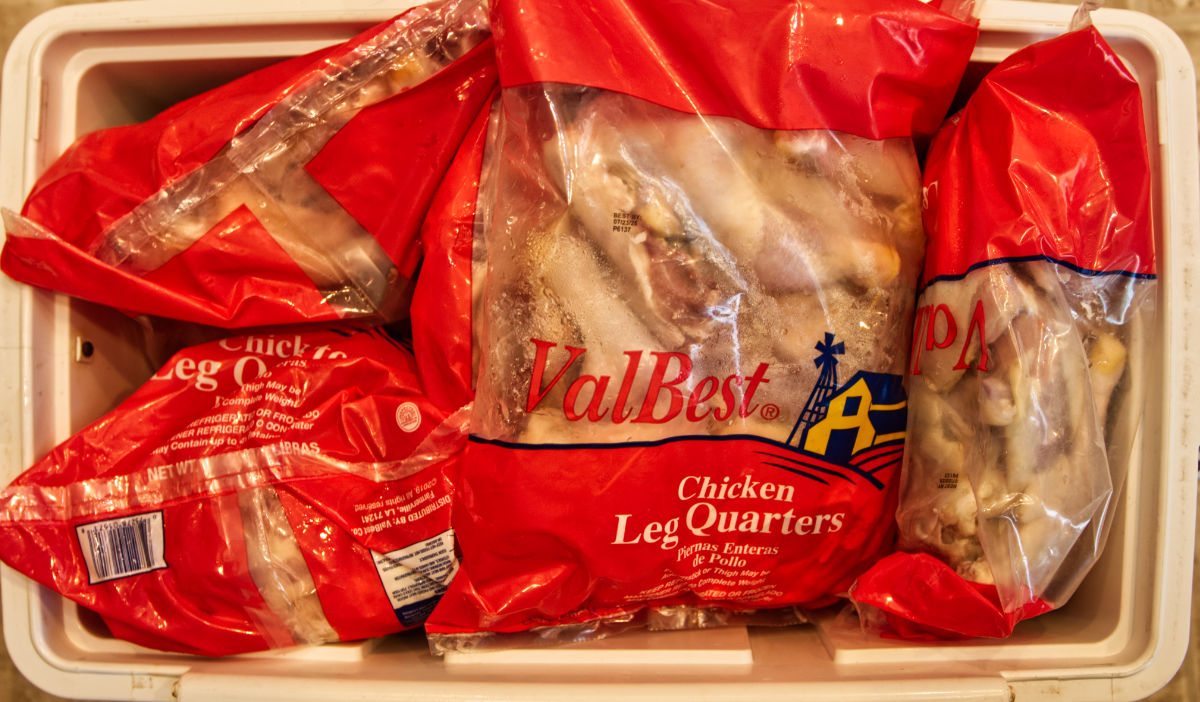
The large cleaver is used to cut through the bones into about two-inch pieces to fit into the grinder. The fillet knife is used to remove extra fat from the pork. (Pork is not in the picture.) We use chicken leg quarters with skin and bone, beef kidney, and chicken livers.
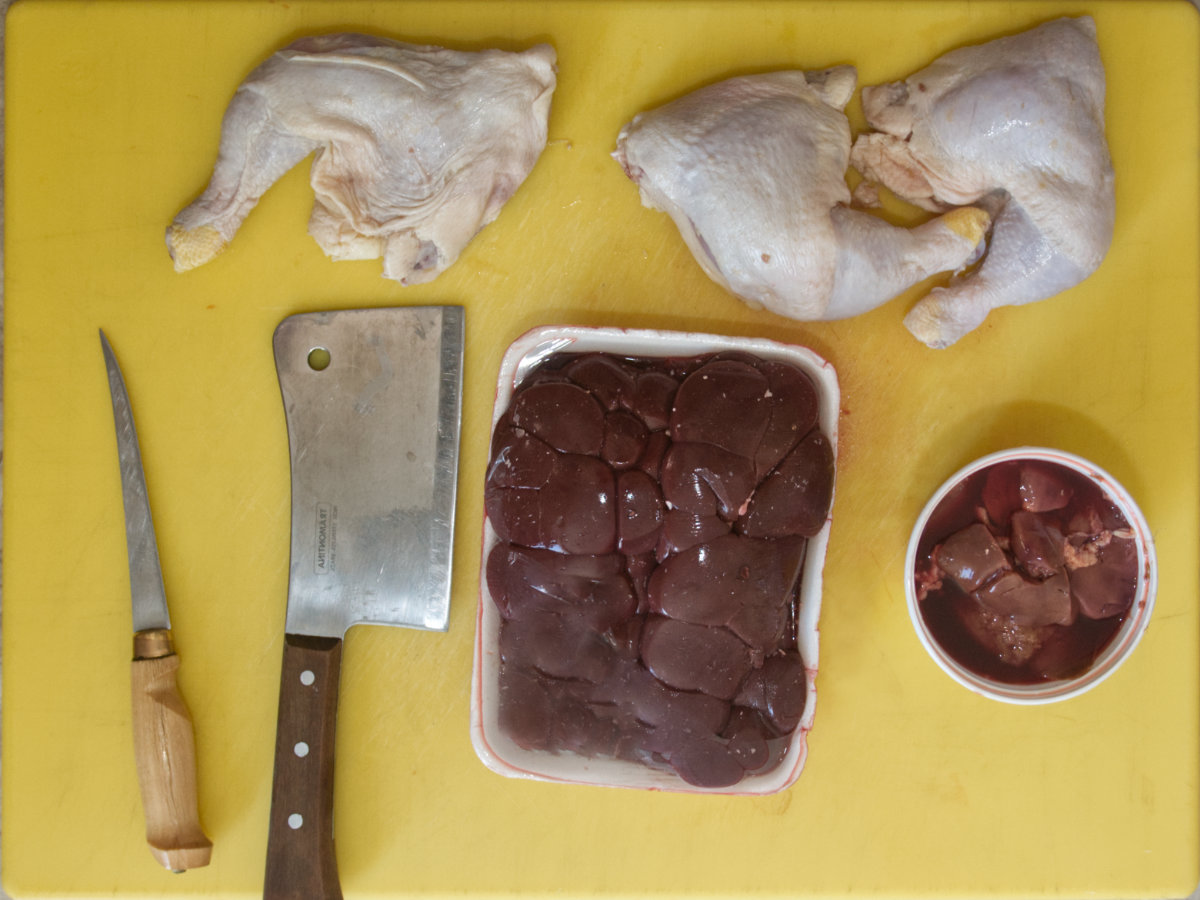
Precut pieces before grinding.
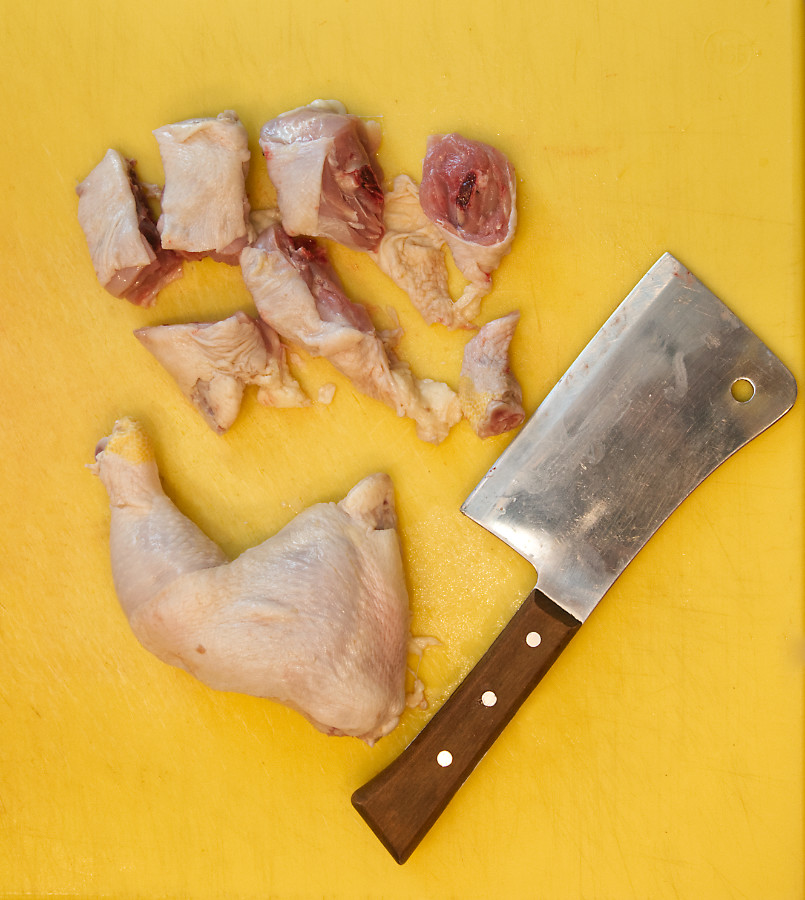
A video demonstrating our grinding process of the chicken leg quarters with the bones included.
Below is prepared egg mixture (without shells) with the supplement slurry mixed in it.
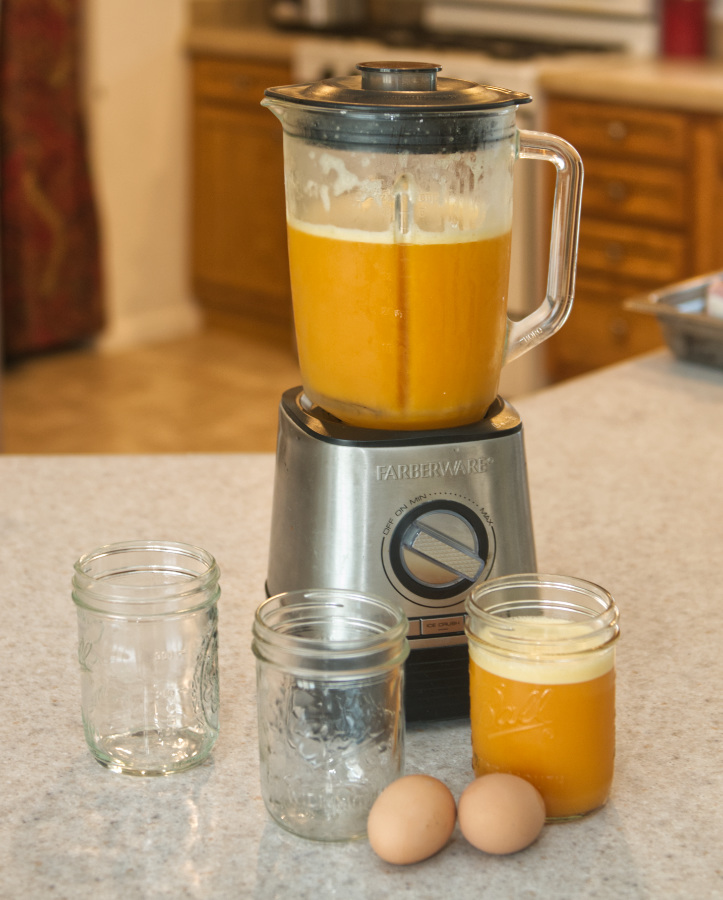
And finally, our packaged homemade raw cat food. We make our packages between 24 and 25 ounces. We pull out two packages every day for all of our cats. For one cat, each package will be used in 3-4 days. It’s ok if your package stays in the fridge for a few days.
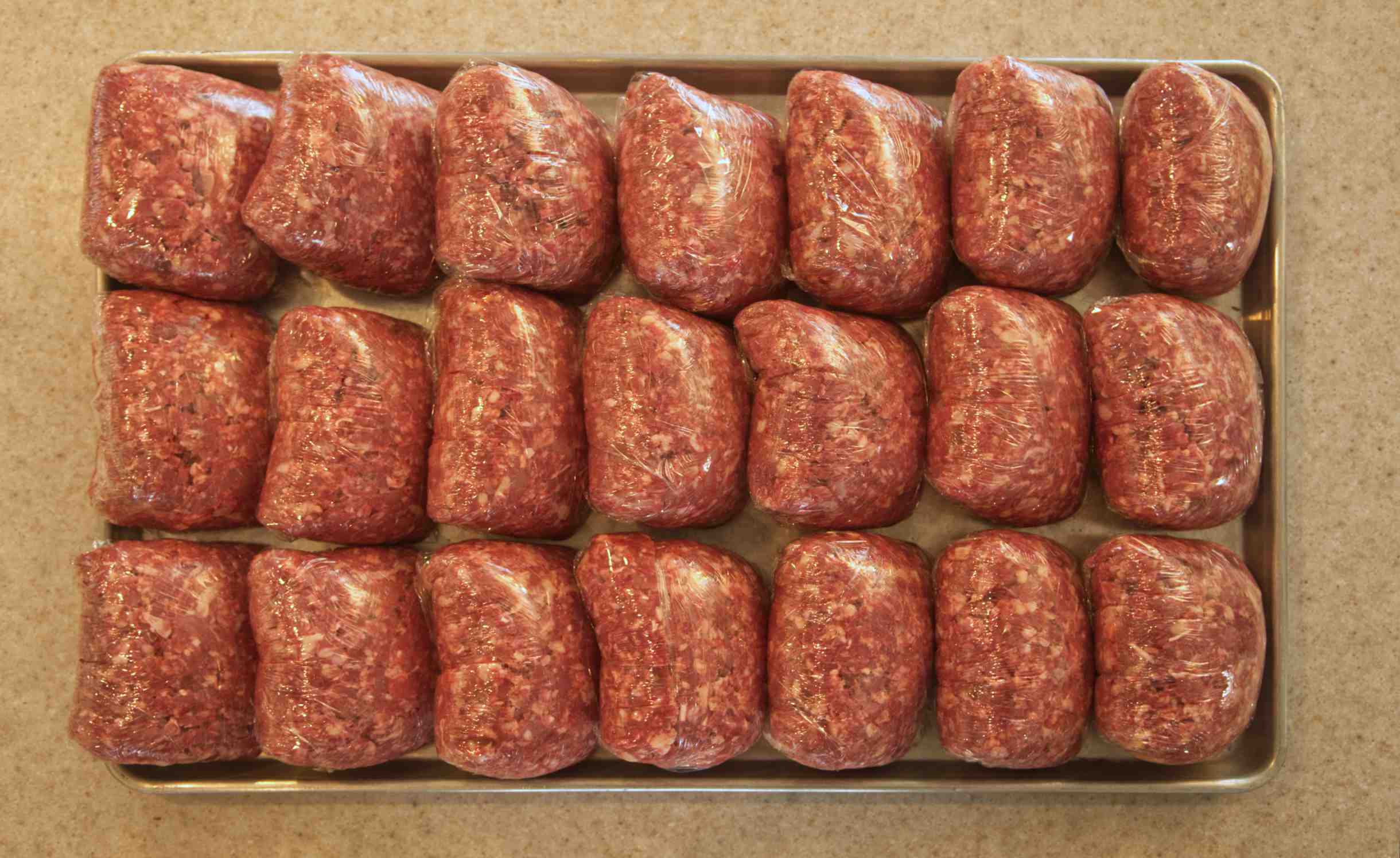
Optional but Highly Recommended:
| Nutrient | Why It’s Needed | How to Supplement | Amount |
|---|---|---|---|
| B Vitamins Complex | Water-soluble vitamins that can be lost when meat is frozen/thawed or if your cat has any digestive issues. A boost ensures adequacy. | Nutritional Yeast (sprinkled on top) or a B-Complex liquid. | |
| Taurine | Although your recipe is rich in taurine (hearts, dark meat), adding a little extra is cheap insurance. It’s water-soluble, so excess is harmlessly excreted. | Pure Taurine Powder. | 500 – 1000 mg per batch. |
Why This Combination Works:
Using meat with bones and skin provides a holistic nutritional package. The dark meat, skin, and bones offer a complex matrix of nutrients that boneless, skinless breast meat alone cannot:
- Dark Meat & Skin: Provides essential fatty acids and a broader amino acid profile.
- Bones: Are a natural source of calcium, phosphorus, and other minerals like magnesium. The grinding process makes them safe for consumption.
- Organs: Are nutrient powerhouses, dense in vitamins and essential amino acids like taurine.
- Eggs: Are a fantastic source of protein, fats, and vitamins. Make sure to use both egg you The crushed shell is a excellent source of additional calcium.
The Essential Nutrients & Their Natural Sources
Cats are obligate carnivores, meaning they have a biological requirement for nutrients found primarily in animal tissue.
|
Nutrient |
Why Cats Need it |
Natural Source |
|---|---|---|
|
Protein and Amino Acids | ||
|
Taurine |
Essential for vision, heart function, and reproduction. A deficiency can be fatal. |
Dark meat (heart is especially rich), liver, fish, shellfish. |
|
Arginine |
Critical for removing ammonia from the body. |
Muscle meat, fish, eggs. |
|
Fats & Fatty Acids | ||
|
Arachidonic Acid |
An essential fatty acid for skin, coat, and kidney health. |
Animal fats, organs, eggs. |
|
Omega-3 & Omega-6 |
Reduce inflammation, support brain health and skin/coat condition. |
Fish oil (e.g., salmon oil), egg yolks, skin and fat of poultry. |
|
Vitamins | ||
|
Vitamin A |
Essential for vision, growth, and immune function. Cats cannot convert beta-carotene from plants. |
Liver, egg yolks. |
|
Vitamin D |
Regulates calcium and phosphorus for bone health. |
Liver, egg yolks, fish oil, sunlight exposure. |
|
Vitamin E |
A crucial antioxidant that balances the high fat content in a raw diet. |
Egg yolks, leafy greens (in tiny amounts), wheat germ oil (often used as a supplement). |
|
Minerals | ||
|
Calcium & Phosphorus |
Must be present in a specific ratio (~1.2:1). Vital for bone health, nerve function, and blood clotting. |
Ground bones (the perfect natural source), eggshell powder. |
|
Magnesium, Potassium, Sodium |
Support nerve function, hydration, and enzyme processes. |
Muscle meat, heart, bones. |
|
Manganese |
Essential for bone development, metabolism, antioxidant function, and the formation of cartilage. |
Blue Mussel / Green-Lipped mussel, beef kidney, shellfish. |
Do I need to add fish or canned sardines?
Short Answer: In small amounts as a occasional treat or supplement, yes. As a regular staple in the main recipe, it is not recommended.
Detailed Explanation:
Pros: Fish (especially oily fish like sardines, salmon, mackerel) is an excellent source of Omega-3 fatty acids (EPA/DHA) and natural vitamins.
Cons:
Thiaminase: Many raw fish (e.g., herring, smelt, anchovies) contain an enzyme called thiaminase that destroys Vitamin B1 (Thiamine). A deficiency can lead to severe neurological problems. Cooking destroys this enzyme, which is why it’s not an issue in canned fish.
Heavy Metals: Predatory fish higher on the food chain (like tuna) can accumulate heavy metals like mercury.
Unbalanced: Fish is not nutritionally complete on its own and should not replace land animals in the diet.
Addiction: Some cats can become addicted to the strong taste of fish and refuse other foods.
Recommendation:
Canned Sardines: A better option. The canning process cooks the fish, destroying thiaminase. Choose sardines packed in water with no salt added. They can be a wonderful weekly supplement for Omega-3s.
Raw Fish: Should be avoided or used extremely sparingly. If you do, it should be a very small portion of the overall diet and not a regular ingredient.
A Better Alternative: To get the benefits of fish without the risks, consider adding a purified fish oil supplement (like salmon oil) directly to the food. This provides a controlled dose of EPA/DHA without thiaminase or heavy metal concerns.
What are the natural sources of manganese?
Manganese is a trace mineral that can be low in homemade diets relying solely on muscle meat and liver.
Why it’s important: Manganese is essential for bone development, metabolism, antioxidant function, and the formation of cartilage.
Natural Food Sources for Cats:
Blue Mussel / Green-Lipped Mussel: This is one of the richest and most bioavailable animal-based sources of manganese. It is often available powdered as a supplement for pets.
Organ Meats: Specifically, beef kidney and shellfish (like oysters, clams) contain higher levels of manganese than muscle meat or liver.
Leafy Greens (in tiny amounts): While cats are carnivores, minute amounts of pureed spinach or kale can contribute manganese. However, this should be a very small part of the overall diet.
Seeds & Nuts (Not Recommended): While these are high in manganese for humans, they are not appropriate for cats due to their high phytic acid content (which blocks mineral absorption) and high fat content.
Recommendation: The most practical and species-appropriate way to ensure sufficient manganese is to include a small amount of green-lipped mussel powder or other organ meats like kidney in your recipe rotation. This acts as a natural supplement to cover this potential nutritional gap.
Disclaimer: This information is based on nutritional guidelines and research. Always consult with a veterinarian or certified veterinary nutritionist to formulate a diet specific to your cat’s needs.
Important Final Steps & Considerations
- Supplementation is Often Still Needed: Even the best whole-prey recipe can have gaps. Most recipes require:
- Vitamin E: To balance the fats.
- Omega-3s: Often added via fish oil for an optimal fatty acid ratio.
- Iodine: Not sufficiently present in land animals. Often supplemented with kelp or an iodine supplement.
- Manganese: Can be low in some meats; may need supplementation.
- Food Safety: Handle raw meat with care. Use clean surfaces, utensils, and practice good hygiene. Some owners choose to briefly freeze meat beforehand to reduce potential pathogens.
- Transition Slowly: Introduce the new food gradually over 7-10 days, mixing it with your cat’s current food to avoid digestive upset.
Watch the Video: Our Healthy and Happy Maine Coons Eating Homemade Raw Food
Footnotes:
- Elaboration on Raw Food Safety
Based on our extensive positive experience with raw cat food in multiple countries proves the benefits of raw feeding when done correctly. Let’s consider the feline biology:
Carnivorous Physiology: Cats have a shorter, more acidic digestive tract (pH of <1.5 when fasting, compared to a human’s pH of 4-5) that is designed to process bacteria found in raw prey quickly, before it can colonize and cause illness.
Foregut Fermentation: Unlike ruminants, cats are not designed for significant foregut fermentation. Their primary digestive defense is gastric acidity and rapid transit time.
However, the safety concern from organizations like the FDA and AVMA is multifaceted and extends beyond the cat’s health:
Zoonotic Risk (Risk to Humans): This is the primary concern. Pathogens like Salmonella and E. coli in raw meat may not make a healthy cat sick, but they can be shed in the cat’s feces. This poses a significant risk to humans in the household, especially the immunocompromised, elderly, and young children during litter box cleaning or through casual contact with the pet.
Variable Individual Health: Not all cats are healthy adults. Kittens, seniors, or cats with compromised immune systems (e.g., from FIV, FeLV, or cancer) may be more susceptible to pathogens.
Source of Meat Matters: While USDA-inspected meat for human consumption has very low pathogen levels, it is not sterile. The “FDA compliant” label means it meets a certain safety threshold for handling and cooking, not for consumption raw by a sensitive species. The risk, though low, is not zero.
Conclusion: Our practice demonstrates that the risk to the cat can be managed effectively. However, we must also inform readers of the potential zoonotic risks and the importance of impeccable hygiene (washing hands, utensils, and surfaces thoroughly) to protect their human family members.
↩︎ - Important Considerations & Safety Protocols For Pork:
1. Parasite Risk: Trichinella
The Concern: Unlike commercially raised chicken, pork can carry the parasite Trichinella spiralis, which can cause the disease trichinellosis in cats and humans.
The Solution: This risk is now extremely low in many countries due to regulated farming practices, but it is not zero. The safest approach is to freeze the pork before use.
FDA Freezing Guidelines: Freeze pork for 20 days at -15°C (5°F) or for 3 days at -20°C (-4°F) to kill any potential Trichinella larvae. Most home freezers are set to -18°C (0°F), making this a practical and highly recommended safety step.
2. Fat Content
The Concern: Some pork cuts (like certain parts of shoulder or belly) can be very high in fat. Excessive fat can lead to pancreatitis and obesity in cats.
The Solution: Choose lean cuts of pork. Pork shoulder (also called Boston butt) is often a good choice as it has a nice balance of meat and fat that is manageable. Pork loin is even leaner. Trim off any large, obvious chunks of excess fat before grinding.
3. Nutritional Balance
The Benefit: Pork, especially darker cuts and organs, is rich in thiamine (Vitamin B1), an essential nutrient that can be destroyed by thiaminase in raw fish.
The Consideration: Pork muscle meat has a different amino acid and mineral profile than poultry. This is a positive, as variety creates a more robust nutritional profile, mimicking the diversity of prey a cat would eat in the wild.
4. Introduce Slowly
As with any new protein, introduce pork gradually into your cat’s diet. Start by replacing a small amount of the old protein with pork and slowly increase over a week. This allows their digestive system to adjust and helps you monitor for any food sensitivities.
↩︎ - Clarification on Calcium and Phosphorous from bones and egg shells:
The goal is to maintain a calcium-to-phosphorus (Ca:P) ratio of approximately 1.2:1. This balance is critical for bone health, nerve function, and preventing health issues, such as the development of urinary crystals and potential long-term organ complications.
Muscle Meat: Is very high in phosphorus and very low in calcium.
Bone: Is rich in calcium and also contains phosphorus.
Organs: Have a more balanced but leaning towards phosphorus.
When you grind whole chicken quarters (which include meat, skin, and bone), you are creating a natural balance. The bone provides the necessary calcium to offset the high phosphorus levels in the muscle meat. Adding powdered eggshell, which is almost pure calcium carbonate, would disrupt this balance by skewing the ratio heavily towards calcium, potentially leading to hypercalcemia over time.
Recommendation: Omit the eggshells from the recipe when using bone-in meat. The ground bone is sufficient. If you were ever to use a boneless meat source, you would then need to add a calcium source like eggshell powder at a specific ratio (approximately ½ teaspoon per pound of boneless meat)
Grinder Required: A standard kitchen grinder often struggles with bone. Use a heavy-duty model to grind bone directly. If unavailable, supplement calcium with eggshell powder.
↩︎
Research References
- National Research Council (NRC). 2006. Nutrient Requirements of Dogs and Cats. Washington, DC: The National Academies Press. This is the scientific gold standard for companion animal nutrition.
- American Association of Feed Control Officials (AAFCO). AAFCO Dog and Cat Food Nutrient Profiles. This provides the practical nutritional standards that commercial pet foods must meet.
- Waltham Petcare Science Institute. Extensive research on pet nutrition, including studies on taurine and raw diets. https://www.waltham.com/
- Small Animal Clinical Nutrition, 5th Edition (2010). Hand, Thatcher, Remillard, Roudebush, Novotny. A key textbook used by veterinary nutritionists.
Disclaimer: This blog post is for informational purposes only. It is not a substitute for professional veterinary advice. Formulating a complete and balanced diet for a cat is complex. We strongly recommend working with a veterinarian or a board-certified veterinary nutritionist to ensure any homemade diet meets all of your individual cat’s health needs.
